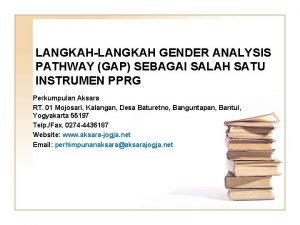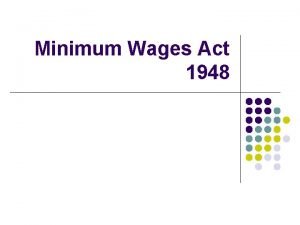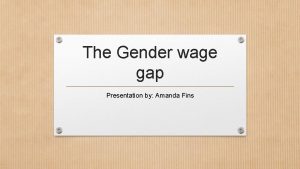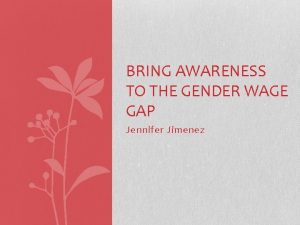EDUCATION AND GENDER WAGE GAP IN GREECE RECENT








































- Slides: 40

EDUCATION AND GENDER WAGE GAP IN GREECE RECENT DEVELOPMENTS

Table 16 Secondary Public and Private Education in Greece, School Year 2005 -2006 Schools Junior High Schools Technical Vocational Schools Total Students Teachers Boys Girls 175, 959 160, 299 113, 477 129, 811 Men Women 13, 768 27, 661 13, 248 13, 368 65, 734 36, 643 355, 170 328, 753 9, 601 7, 578 36, 617 48, 607

Table 14 Women in Higher Education Postgraduate Students Year 2005 -2006 -2007 -2008 Total 171, 967 171, 857 170, 422 Women 102, 353 102, 569 102, 792 % Women. Total 59. 52 % 42, 930 59. 68 % 47, 784 60. 32 % 49, 347 Women % Women 21, 283 49, 58% 24, 464 51, 20% 24, 754 50, 16%

Women’s participation in responsible posts within the Public Sector Table 4 Rates of women’s participation in head posts in Ministries, PLLE and LGO 1996 2002 2005 2007 General Directors No class or post stipulated 40. 4% 37. 7% Ministries: 40% PLLE: 69. 6% LGO: 36. 7% Average: 48. 9% Directors 24. 5% 36% 34. 5% Ministries: 35. 5% PLLE: 62. 2% LGO: 39. 4% Average: 45. 7% Department Heads 37. 8% 50. 7% 46. 3% Ministries: 46. 4% PLLE: 76. 3% LGO: 44% Average: 55. 6% Average 31. 15% 42. 3% 39. 5% 50. 1%

PARTICIPATION OF GENDER GROUPS IN ENGINEERING WORKPLACE ENGINEERING DEGREES AWARDED FROM 2004 TO 2008 % Gap Between Men & Women Degree Awarded Women Men Architecture 1274 1258 0. 6% Civil Engineering 720 4401 71. 9% Computer Science Engineering 735 2129 48. 7% Electrical Engineering 533 2616 66. 1% Electronic Engineering 1168 4767 60. 6% Mechanical Engineering 413 8547 90. 8% 4843 23718 66. 1% Total HUMAN RESOURCE & DEVELOPMENT 1980 2000 % Chg in M/F Gap % of Engineering Degrees Male Female M/F Gap 261 279 18 Male Female M/F Gap 222 209 13 -46. 2% % of Workforce Participation 66% 34% 32% 68% 32% 36% 12. 5% 5

Table 1 Persons employed , 15 -64 years , by education level and skillfulness ( ISCED code ), in Greece and Europe an Union , 2005 Source : European Commission DG-Employment and Social Affairs, Employment in Europe 2006. Σύνολο Total Medium High Low Males Medium High Low Females Medium High skilfulness Low Greece 40, 8 41, 6 17, 6 40, 5 41, 4 18, 1 41, 8 17, 1 ΕU -25 32, 8 47, 3 19, 9 32, 1 48, 0 19, 9 33, 5 46, 6 19, 9

Source : European Commission DG-Em ployment and Social Affairs, Employment in Europe 2006 Table 2 Participation % in Labour Force 15 -64 years , by εducation (ISCED level , ( ISCED code ), in Greece και and European Union , 2003 Total Low level of Education Medium level of Education High level of Education Greece ΕU 15 ΕU- Greece ΕU-15 ΕU-25 25 Greece ΕU-15 ΕU-25 Greece ΕU-15 ΕU-25 63, 8 69, 9 69, 2 54, 3 66, 0 75, 5 86, 8 55, 7 53, 0 76, 1 86, 3

Table 19 Employment and Unemployment Percentages per Sex, 2004 and 2008 Employment. Percentage Men 2004 2008 Women 2004 2008 74. 0 75. 4 45. 5 49. 0 Unemployment Percentage 6. 5 4. 8 16. 0 11. 1

Employment rate : Persons employed 15 -64 years, as percentage of population 15 -64 years Part - time rate : Percentage % of total Employment Unemployment rate : Unemployment persons 15 years and over as Percentage % of labour force Source : European Commission DG-Employment and Social Affairs, Employment in Europe 2006. Table 3 3 (ISCED rates in Greece and European Union, by education level and sex, 2004 Low level of Education Medium level of Education High level of Education Greece ΕU-15 Total Employment rate 49, 5 49, 2 46, 2 60, 7 70, 1 68, 3 81, 2 82, 5 Part-time rate 5, 4 18, 5 18, 3 4, 2 20, 9 17, 9 3, 5 15, 8 14, 5 Unemployment rate 9, 6 11, 8 12, 4 8, 1 9, 6 7, 9 5, 1 Males Employment rate 74, 0 60, 8 57, 0 74, 3 76, 3 74, 6 88, 0 86, 0 Part-time rate 2, 2 6, 4 6, 8 2, 1 6, 2 1, 6 6, 4 6, 1 Unemployment rate 6, 3 10, 4 11, 5 7, 6 9, 0 4, 6 3, 7 Females Employment rate 32, 3 38, 0 36, 0 47, 4 63, 8 61, 8 75, 2 78, 9 Part-time rate 11, 9 37, 1 35, 7 7, 5 38, 4 32, 6 6, 0 26, 4 23, 9 Unemployment rate 15, 5 13, 7 14, 6 18, 9 8, 8 10, 4 11, 8 5, 7 5, 8 ΕU-25 Greece ΕU-15 ΕU-25

Source : National Statistical Service of Greece Table 4 Labour Force by education level and sex (2007) (in education level thousands ) Females Males Both sexes Received a post graduate qualifications 37, 0 53 90, 3 Received a university degree 392, 6 415, 9 808, 5 Received a third-level technical-vocational institutional degree 389, 0 409, 9 798, 9 Completed secondary level education 628, 1 999, 0 1627, 1 Completed the third stage of 6 -year secondary education 171, 2 381, 7 552, 9 Completed primary education 359, 5 617, 5 977, 0 completed primary education 14, 8 18, 7 33, 5 Attended no school at all 9, 0 9, 6 18, 6 2. 001, 3 2. 905, 6 4. 906, 9 Total

Source : National Statistical Service of Greece (in thousands) Table 5 Persons employed , by education level and sex Females education level 2003 Received a post graduate qualifications Received a university degree Received a third-level technical-vocational institutional degree Completed secondary level education Completed the third stage of 6 -year secondary education Completed primary education completed primary education Attended no school at all Total Males 2007 2003 2007 11, 2 33, 9 21, 1 50, 6 299, 8 361, 3 359, 0 399, 5 252, 0 326, 9 306, 1 379, 8 467, 3 521, 3 830, 0 939, 5 121, 9 140, 2 348, 3 361, 1 389, 8 317, 9 740, 7 582, 0 22, 3 13, 7 26, 8 17, 9 15, 1 7, 3 13, 0 8, 3 1. 579, 5 1. 722, 4 2. 644, 9 2. 738, 8

Source : National Statistical Service of Greece ( 1 st quarter 2007 , in thousands ) Table 6 Persons employed 15 years end over with part-time job by education level and sex (2007) education level Females Males Both sexes Received a post graduate qualifications 2, 0 1, 7 3, 7 Received a university degree 27, 1 9, 2 36, 4 Received a third-level technicalvocational institutional degree 24, 0 7, 7 31, 7 Completed secondary level education 52, 8 23, 0 75, 8 Completed the third stage of 6 -year secondary educ. 20, 4 10, 0 30, 4 51, 3 22, 4 73, 7 Have completed primary education 2, 9 1, 9 4, 8 Attended no school at all 1, 8 0, 4 2, 1 182, 3 76, 3 258, 6 Completed primary educ. Σύνολο Total

Source: National Statistical Service of Greece (1 st quarter 2007, in thousands) Table 7 Unemployed females 15 years end over by education level and age groups (2007) AGE GROUPS 15 -19 years 20 -24 years 25 -29 years 30 -44 years 45 -64 years 65 years and over Received a post graduate qualific 8, 8 -- 46, 1 -- 57, 0 1, 8 117, 5 0, 7 49, 1 0, 7 0, 3 -- Received a university degree -- 7, 5 9, 0 12, 7 2, 1 -- Βαθμός Received a third-level te chnical-vocational institute. degree 0, 3 13, 4 18, 3 26, 0 4, 1 -- Completed secondary level education 5, 8 20, 6 19, 3 44, 9 16, 2 -- . Completed the third stage of 6 year secondary educ. 1, 7 3, 5 5, 2 15, 6 5, 0 -- Completed primary educ. 1, 0 3, 4 16, 5 19, 3 0, 3 completed primary educ. -- -- -- 0, 1 1, 1 -- Attended no school at all -- 0, 2 -- 0, 9 0, 6 -- education level Total Females

Source: National Statistical Service of Greece (1 st quarter 2007, in thousands) Table 8 Unemployed males 15 years end over by education level and age groups (2007) AGE GROUPS education level 15 -19 years 20 -24 years 25 -29 years 30 -44 years 45 -64 years 65 years and over Total males 7, 3 30, 7 40, 0 57, 8 30, 4 0, 6 Received a post graduate qualific ation -- 0, 4 1, 2 0, 8 0, 3 -- Received a university degree -- 1, 2 6, 4 7, 4 1, 4 -- Received a third-level technicalvocational institute. degree 0, 1 6, 5 11, 1 9, 2 2, 9 0, 3 Completed secondary level educ. 4, 1 15, 8 13, 1 20, 9 5, 4 -- Completed the third stage of 6 -year secondary educ. 0, 9 3, 4 5, 0 9, 0 2, 5 -- Completed primary educ. 2, 1 3, 3 3, 1 10, 1 16, 6 0, 3 Have not completed primary educ. -- -- -- 0, 2 0, 5 -- Attended no school at all 0, 1 0, 2 -- 0, 3 0, 8 --

Source: National Statistical Service of Greece (1 st quarter 2007, in thousands) Table 9 9 Persons employed 15 years end over by education level, occupational status and sex (2007) education level Employers Own-account workers Salaries employees Unpaid family workers Total Females Received a post graduate qualifications 73, 8 1, 2 285, 0 6, 2 1. 175, 2 26, 1 188, 5 0, 4 Received a university degree 17, 9 44, 8 8 291, 5 7, 1 Received a third-level technical-vocational institutional degree Completed secondary level education 10, 5 26, 9 277, 5 11, 9 23, 5 66, 5 378, 6 52, 7 Completed the third sta ge of 6 -year secondary educ. 8, 1 25, 9 84, 2 22, 0 Completed primary education 11, 9 107, 2 113, 4 85, 3 Have not completed primary education 0, 5 5, 3 2, 0 5, 9 Attended no school at all 0, 2 2, 2 1, 8 3, 1 Total males Received a post graduate qualifications 288, 3 3, 3 679, 5 7, 4 1. 663, 4 39, 6 107, 6 0, 4 Received a university degree 46, 8 75, 5 272, 8 4, 4 Received a third-level technical-vocational institutional degree Completed secondary level education 32, 4 55, 6 281, 7 10, 2 105, 3 191, 9 596, 6 45, 7 Completed the third stage of 6 -year secondary educ. 36, 9 97, 1 209, 4 17, 7 Completed primary education 61, 5 238, 6 254, 7 27, 2 Have not completed primary education 1, 4 10, 1 5, 0 1, 4 Attended no school at all 0, 7 3, 4 3, 6 0, 7

TABLE – Statistics on women’s status in Greece and in the European Union Reference Greece European Union Women Men Employment rates (women and men aged 15 -65), 2010 48. 9% 73. 5% 58. 6% 70. 7% 27. 7% 33. 1% 37. 2% 64. 3% 44. 6% 61. 95% Employment rates (women and men aged 15 -24), 2010 Employment rates (women and men aged 55 -64), 2010 18. 1% 32. 0% Unemployment rates (women and men aged 15 -64), 2010 15. 7% 9. 7% 10. 2% 9. 9% Unemployment rates (women and men aged 15 -24 2010 40. 4% 25. 5% 19. 5% 20. 7% 13. 8% 8. 6% 9. 2% 8. 7% 6. 0% 2. 4% 3. 1% 2. 9% Unemployment rates (women and men aged 25 -64), 2010 Share of long-term unemployed (women and men 15 and over), in 2009 Pay gap in EU Member States, in 2008 22. 0% 17. 5% Percentages of inactive and partially active women due to the lack of care services for children and the elderly (Ju 68. 5% _ 26. 7% 25. 9% Care of children at the age of 0 -3 (Barcelona target is 33%) (2005) 7. 0% 24. 0% Care of children from 3 years old up to the age of compulsory education (Barcelona target is 90%) (2005) 60. 0% 82. 4% Women and men with High Education level, in 2009 59. 0% 41. 0% Unemployment rates by sex and educational attainment level (Ph. D or Master degree holders), in 2009 9. 7% 5. 8% 4. 8% 3. 7% Participation rates (women and men) in National Parliaments European Commission, 17. 3% 82. 7% 26. 0% 74. 0%

Participation rates (women and men) in senior posts in enterprises, in 2008 Participation rates (women and men) in Boards of Directors of the biggest listed companies, in 2009 in decision-making 29. 0% 71. 0% 32. 5% 67. 5% 95. 0% 11. 0% 89. 0% 20. 7% 19. 6% 17. 5% 15. 6% Employees at the risk of poverty, in 2008 12. 1% 15. 9% 7. 9% 9% Non employed persons at the risk of poverty, in 2007 26% 23% 25% 23% Unemployed persons at the risk of poverty, in 2007 31% 41% 39% 47% Pensioners at the risk of poverty, in 2008 23. 6% 20. 8% 21. 2% 15% Other inactive persons at the risk of poverty, 2007 25% 27% 28% 26% 5. 0% Population percentage 18 years old at the risk of poverty, in 2008 Deaths of women – victims of domestic violence (homicides 2007) Public Security Division, 1 st Special Crime Squad Deaths of women – victims of domestic violence (homicides 2008) 10 women victims Deaths of women – victims of domestic violence (homicides 2009) 13 women 17 women victims

Table 1 Women’s participation in the National Parliament Year 1996 2000 2004 2007 2009 • • Total Women % Women 300 19 6. 3 300 31 10. 3 300 39 13 300 48 16 300 52 17. 3 A slight improvement from 43 (9%) in the 1999 election to 61 (11. 09%) in the 2004 election. Electoral system used in 1999 is proportional with closed-list system. In the 2004 election, the proportion is “half -opened”. Meaning that the internal mechanism in the political party still have the strong hold of the political party list in the recruitment system.

Table 2 Rates of women candidates for regional, municipal and local councils 2006 women candidates for Municipal Elections 32% women candidates for Region Councils 29% women candidates for Local Councils 36%

Table 3 European Elections Results, 2004 gender Seats Women Men 2004 24 8 16 2009 22 7 15 & 2009 per % Women 33. 3 31. 8

CURRENT TRENDS OF WOMEN IN THE ORGANISATIONAL HIERARCHY IN THE GREEK IT FIRMS q. High percentage of women in q. Quality management q. Human Resource management q. Programming q. Technical Writing q. Low percentage of women in q. IT operations q. Database administration q. Network administration q. Percentage of women in Senior management low in comparison to western countries q. Percentage of women in project management steadily rising IT - the Industry with one of the highest growth rate of women 21

Table 23 Average time dedicated to domestic and family duties and to employed work per week (data for 2005)1 Women Men Gender Difference Domestic and family duties Paid employment 28. 8 -9. 5 43. 6 7. 1 53. 1 21. 7

Table 24 Non-active Population aged 25 -64 per sex: Reasons for not searching for employment Women Men Reasons of non searching of employment 2004 Waiting to take over a working post : Suffering from a disease or incapability 3. 5 Other family/ personal duties 43. 9 Taking care of children or dependent adults : They are students 1. 2 They are pensioners 14. 2 Believing that there are no jobs available 0. 7 Other reasons 36. 5 2008 : 4. 7 36. 5 8. 6 2 14. 7 0. 9 32. 7 2004 : 20 1. 6 : 6. 2 67. 2 : 4. 5 2008 : 20. 1 1. 2 : 7. 4 65. 6 0. 8 4. 8

WOMEN’S ECONOMIC EMPOWERMENT HUMAN RIGHTS GENDER-RESPONSIVE GOVERNANCE The Greek Framework Plan for Women

Recommendations For women in administrative and technical positions: Provide business communications training Provide intensive English language training

Recommendations For women in support positions such as cleaners and tea servers: Conduct a relevant needs assessment

Recommendations For women who will be displaced in the civil service reform process: Provide opportunity for retraining as teachers Provide intensive English language training

The National Strategic Reference Framework (NSRF) 2007 -2013, Operational Programme (OP) “Public Administration Reform”, is the central funding framework of these policies and activities The Programme is structured on three pillars. They entail, respectively: a. proposed legislative regulations to improve family law, reform and enhance legislation addressing violence and introduce new provisions aimed at substantive gender equality; b. GSGE specialised gender equality policies (interventions in selected areas of public policy and creation of policy making institutions, structures and bodies); and c. interventions by other Ministries and public agencies which foster gender equity via public policies (mainstreaming policies).

Recommendations For women who will enter the civil service in the near- and medium-term future: Assist in GTZ research project on civil service employment for women

Gender Analysis of Civil Service Training Working Towards equal opportunities for women in the civil service

Introduction Report Purpose Commitments to Gender Equality by Greek Government Methodology

Women in the Civil Service Statistics Current Environment Categories Civil Service Reform

OBJECTIVES Provide, greek government agencies, and development practitioners with a common set of analytical concepts and tools for integrating gender concerns into development programs and projects Help achieve gender equality in, and empower women through, projects and programs

Statistics number of civil servants 1. 100. 000 gender-disaggregated data 180, 000 to 325, 000 total One estimate 38, 000 women One estimate 60% of women teachers

Current Environment Lack of central coordination and tracking Lack of merit-based selection system Lack of post-training evaluation Lack of post-training information sharing Fossilized/discriminatory civil service infrastructure

Categories Women in senior- and mid-level managerial and policy-making positions Women in administrative and technical positions Women in support positions such as cleaners and tea servers Women who will be displaced in the civil service reform process Women who will enter the civil service in the near- and medium-term future

Civil Service Training No centralized coordination or tracking Attempt at general inventory by ministry and provincial administration Source – ministries, NGO’s and training providers

Recommendations General: Greek government should hold government officials publicly responsible for a commitment to gender equality Independent Administrative Reform & Civil Service Commission should form an equity unit Implement process immediately with gender component Implement gender-sensitive merit-based selection processes for training attendees. Ministries and donors participate in central training tracking

Recommendations For women in senior- and mid-level managerial and policy-making positions: Provide business communications training Provide training for effective access to women in the Parliament

Thank you and Welcome to Discussion…. . Amoutzias. dimitris@n 3. sezefxis. gov. gr
 Strategic gender needs and practical gender needs
Strategic gender needs and practical gender needs The simple truth about the gender pay gap
The simple truth about the gender pay gap Gender pay gap lösungsansätze
Gender pay gap lösungsansätze Contoh gender analysis pathway (gap)
Contoh gender analysis pathway (gap) Bogʻlovchisiz qoʻshma gaplar
Bogʻlovchisiz qoʻshma gaplar Specification gap is gap between
Specification gap is gap between Sparta and athens physical education
Sparta and athens physical education Rowan plan
Rowan plan Job grade meaning
Job grade meaning What is a wage
What is a wage Wage and workplace standards ct
Wage and workplace standards ct Greek education system
Greek education system Recent trends in ic engine
Recent trends in ic engine Recent developments in ict
Recent developments in ict Recent developments in object detection
Recent developments in object detection Is college worth it synthesis essay
Is college worth it synthesis essay Foreign trade
Foreign trade Advantages of scanning and skimming
Advantages of scanning and skimming Modern trends in project management
Modern trends in project management Recent demographic changes in the uk
Recent demographic changes in the uk Powerschool myips
Powerschool myips During a recent police investigation
During a recent police investigation Jose has just played a long bruising football game
Jose has just played a long bruising football game A friend emails you the results
A friend emails you the results Recent advances in dental ceramics
Recent advances in dental ceramics Passive voice in the news
Passive voice in the news Https drive google com
Https drive google com Udin login
Udin login Mis trends
Mis trends Comait
Comait Mathsrevision
Mathsrevision What is a wage
What is a wage What is time rate wage system
What is time rate wage system Gdp deflator
Gdp deflator Mdot prevailing wage
Mdot prevailing wage Croatia minimum wage
Croatia minimum wage Minimum wage
Minimum wage The minimum wage act 1948
The minimum wage act 1948 Average wage in romania
Average wage in romania Real gdp
Real gdp The minimum wages act 1948
The minimum wages act 1948































































